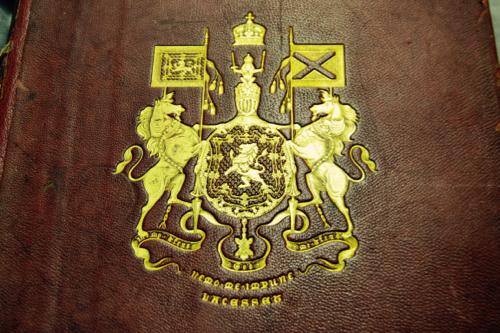
Author
John Sobieski Stuart (1795-1872)
Title
Vestiarium Scoticum: From the Manuscript Formerly in the Library of the Scots College at Douay
Published
Edinburgh: William Tait, 1842
Location
391.00941 FM81

What is this book about?
The Vestiarium Scoticum is a book of tartanry – ‘probably the most controversial costume book ever written’, according to John Telfer Dunbar (History of Highland Dress, 112). Published as a limited edition by William Tait in Edinburgh in 1842, the book purports to be printed from a manuscript that had been discovered at the Scots College in Douay, in northern France. Its editor (and the author of its introduction and notes) is John Sobieski Stuart. The book consists of a black-letter description of the clans and their tartan, followed by elaborate colour plates. The introduction is in ‘modern’, regular nineteenth-century prose, while the ‘manuscript’ section is reminiscent of Thomas Chatterton’s Rowley poems.






Why does this book matter?
The book is important – for its content, for its design, for its authors, and for the controversy it caused. John Telfer Dunbar, again: ‘What are we to think of the Sobieski Stuarts and their Vestiarium Scoticum? Having seen so much of their handiwork as writers, artists, designers, wood-carvers and even furniture-makers, I have a great admiration for their talents. I cannot, however, accept the Vestiarium as genuine’ (21).
John Sobieski Stuart, born John Hay (or Carter) Allan (or Allen), was one half of the notorious nineteenth-century ‘Sobieski Stuarts’ together with his brother, Charles Hay (or Manning) Allan (or Allen), who styled himself ‘Charles Edward Stuart’. They were born in Wales, but in 1871 gave Versailles as their place of birth. They dabbled in old manuscripts and poetry, and tried to convince Sir Walter Scott of the authenticity of some of their ‘found’ works. They claimed direct descent from Charles Edward Stuart – their supposed grandfather. A pair of hoaxers, inventors and benign charlatans, the Vestiarium Scoticum remains the Sobieski’s most controversial, but also most impressive work.
Whether or not it is genuine, the book is beautiful – beautifully set, beautifully illustrated, and anyone with an interest in Scottish culture, history or tartan should find this book interesting. In Inverness we also have a copy of Dubar’s History of Highland Dress (391.0941 Reference), and this makes an excellent companion volume to the Vestiarium Scoticum.
